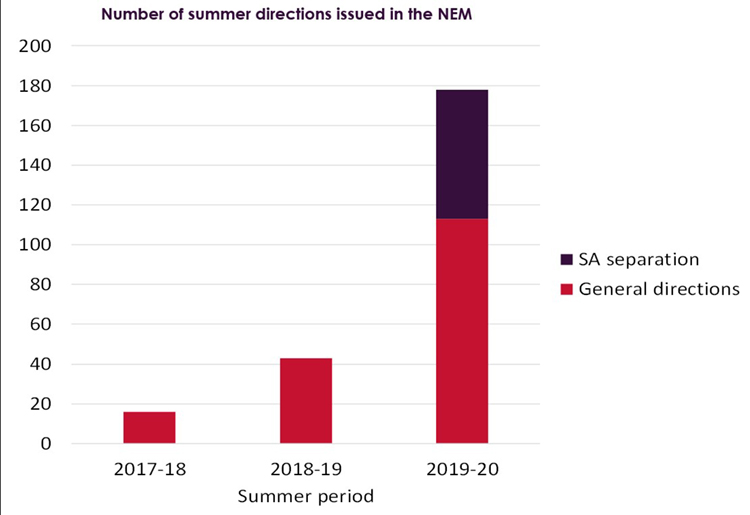The impact of unprecedented and catastrophic fires coupled with other extreme weather events experienced throughout Australia last summer highlights the need to strengthen resilience across Australia’s electricity and gas networks, supported by fit-for-purpose regulatory arrangements.
AEMO’s National Electricity Market (NEM) Summer Operations Review, published today, considers the effectiveness of preparations undertaken by AEMO, state governments and NEM participants ahead of summer, and subsequent real-time efforts managing power system events during the season. It covers the conditions experienced last summer and identifies a range of potential improvements to support secure, affordable and reliable operations into the future.
AEMO Managing Director and CEO, Audrey Zibelman, said that Australia’s physical electricity infrastructure is being increasingly challenged by longer lasting and more extreme climatic and bushfire conditions, which threaten and degrade transmission and generation infrastructure, as well as create forecasting challenges as fire, ash, smoke and haze impact transmission networks and solar output.
“The preparations by AEMO and the industry contributed to mitigating the potentially extensive and significant power-system impacts of a season characterised by record high temperatures, catastrophic bushfires, significant smoke, dust, and violent storm activity,” Ms Zibelman said.
“Despite unprecedented challenges, power system security was maintained. This outcome was achieved through having sufficient reserves available throughout the summer and a great deal of hard work across the industry to manage through a number of very complex and challenging climate-related events.
“What’s clear from our experience last summer, is that planning is essential and it’s critical for AEMO with governments, industry and other stakeholders to assess how we can best assure the resilience of Australia’s energy infrastructure to these rare but extreme the events,” she said.
New interconnections between states, integration of wholesale demand response, more flexible market design and interim reliability measures agreed by energy ministers in March all need to be progressed. Doing so will add resilience as well as deepen competition, ensuring the energy system’s ability to manage extreme weather shocks is cost-effectively enhanced. In addition, consideration of how regulatory processes may better consider resilience benefits in network projects is warranted.
Key outcomes in the NEM during the 2019-20 summer period:
- Temperature: Australia's second warmest on record.
- Energy demand: Largest underlying demand on record (38,055 megawatts on 31 January 2020),
- Matching energy supply and demand: AEMO declared 28 Lack of Reserve (LOR) conditions, eight ‘actual’ LOR2s (four in NSWs, three in Victoria, and one in South Australia).
- Transmission network separation events: Six separation events occurred, compared to zero in the prior summer. A separation event is an electrical disconnection between NEM regions (states) although they can also occur within a region resulting in part of one state being isolated from the rest of the state and supplied from another region. Separation events reduce the supply that can be shared between states, reducing resilience, competition and creating additional operational challenges for the power system.
- Market interventions:
AEMO issued 178 directions to deal with actual or potential supply
shortages or system security issues, representing a ten-fold increase over
the past three years. The majority (65) were issued to maintain system
strength in South Australia when the state was separated or ‘islanded’
from the rest of the NEM.

- Coal, gas, wind and
solar generation: Consistent with previous extreme heat events,
conventional generators experienced material output deratings. Additionally,
and for the first time, AEMO observed that certain extreme temperatures
led to some wind turbines cutting-out across South Australia and Victoria.
Dust exacerbated by the drought and bushfire smoke, ash and dust storms also
materially impacted grid-scale and rooftop PV solar generation forecasts.
- Activation of
off-market energy reserves: Prior to summer, AEMO procured 137 MW of
long notice reserves for Victoria and 1,698 MW of medium and short notice
reserves across the NEM through the Reliability and Emergency Reserve
Trader (RERT) mechanism. AEMO activated RERT capacity of between 68 MW and
185 MW in response to high demand and low generation reserves on four days
at a total cost of $39.8 million, avoiding involuntary load shedding if critical
generation or transmission failed during these periods. The RERT volumes and
prices equate to power to serve approximately 34,000 to 92,500 homes and an
associated societal cost of $87 million. Assuming these RERT costs are
proportioned on a consumption basis, the average cost per household is
estimated to be about $3.24 in New South Wales and $2.43 in Victoria.
Ms Zibelman said the outcomes from last summer emphasised
the value of the preparations taken prior to the start of the season.
“The process for preparing for summer 2020-21 will be
similar, as far as possible, to that undertaken for this summer with additional
challenges due to the impact of the COVID-19 pandemic,” she said.
The Australian Competition and Consumer Commission (ACCC)
has granted interim authorisation to AEMO to allow electricity industry
participants to co-operate on certain measures to ensure safe, secure, and
reliable operation of Australia’s energy systems, ongoing energy supply, and
integrity of wholesale markets during the COVID-19 pandemic. AEMO will use this
process where necessary to manage generator and transmission maintenance so it
can be completed prior to summer.
For all the latest news, insights and analysis from
the Australian energy industry subscribe to our fortnightly
newsletter and download the Energy Live app on Apple or Android.






